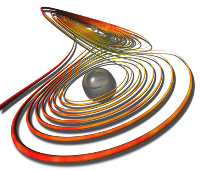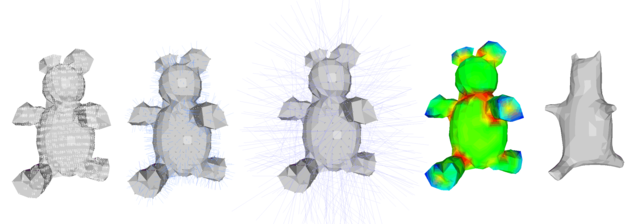Fundamentals of Geometry Processing
Abstract
Geometry processing refers to the design efficient algorithms for the acquisition, representation, reconstruction, optimization, and transmission of geometric information. Because geometric data becomes increasingly important for the development and communication of technical systems and context, efficient processing of geometric data has become a key technology.
Content
This course covers basic mathematical foundations for studying 3D surfaces from a discrete geometric standpoint and present the full geometry processing pipeline: from 3D data capture, mesh smoothing, surface reconstruction, parameterization, registration, shape analysis (correspondence, symmetry, matching), data-driven synthesis, interactive manipulation, conversion form one shape representation to another, to 3D printing. Which topics from this selection are covered vary each year and will be announced in the first lecture.
Mode
Lecture slides and accompanying videos will be provided via the teaching centre and local webservers. In addition to the lecture material provided lectures will be held in presence in the lecture hall to provide additional information on the online material and answer questions students may have relating to the video lectures. Each student will be provided with a Gitlab account to receive and submit assignments and exam. Students are required to regularly check the newsgroup (tu-graz.lv.fgp) and email for updates and additional information. Communication will take place via Webex and discord. The last two tools are helpful, but not compulsory. Working camera, microphone and speakers are helpful, but not required to participate in this course.
Grading
To complete the course, students need to complete the following:
- Three assignments based on implementation work. All three assignments are handed out at the beginning of the course via Gitlab. The assignments are handed in via Gitlab. On submission of the assignment, each student will receive immediate feedback whether the implementation work is correct. On each assignments students may receive a maximum of 20 points. After the last assignment is handed in, there will be a compulsory exercise interview (Abgabegespräch).
- An exam will be held online sometime at the end of the course. Please check current slides for exact dates. The exam will cover mathematical foundations required to do geometry processing and understanding of geometry processing algorithms. The maximum number of points achievable for the exam is 40 points.
Contact
Assoc. Prof. Ursula Augsdörfer M.Sc., Ph.D., u.augsdorfer@cgv.tugraz.at , Business card
Assoc. Prof. Ursula Augsdörfer M.Sc., Ph.D., Business card, u.augsdorfer@cgv.tugraz.at
Prof. Johannes Wallner, Business card,

